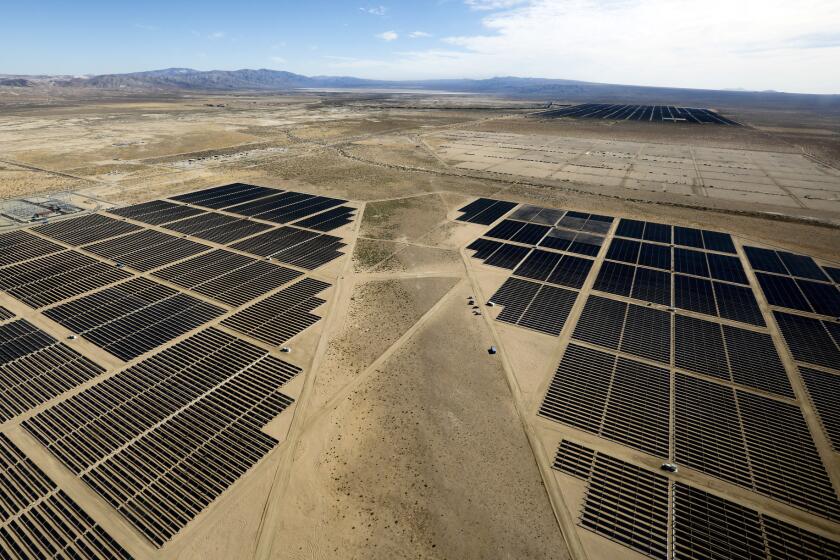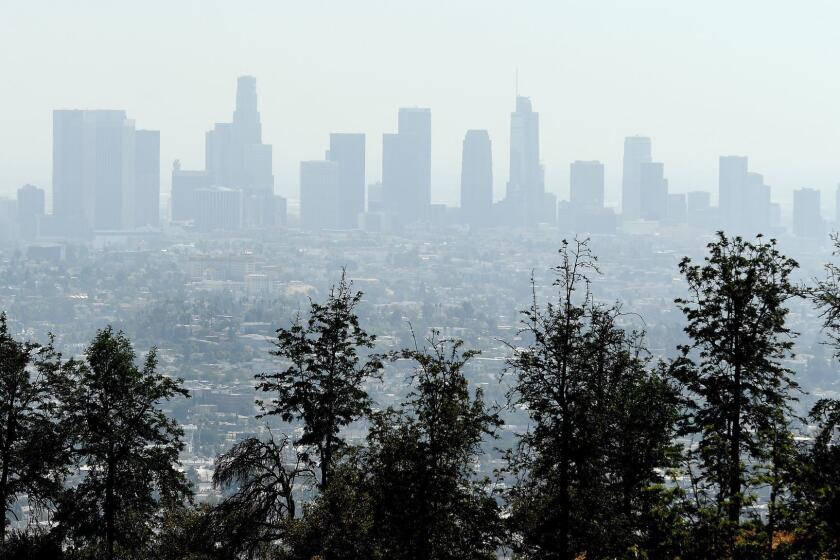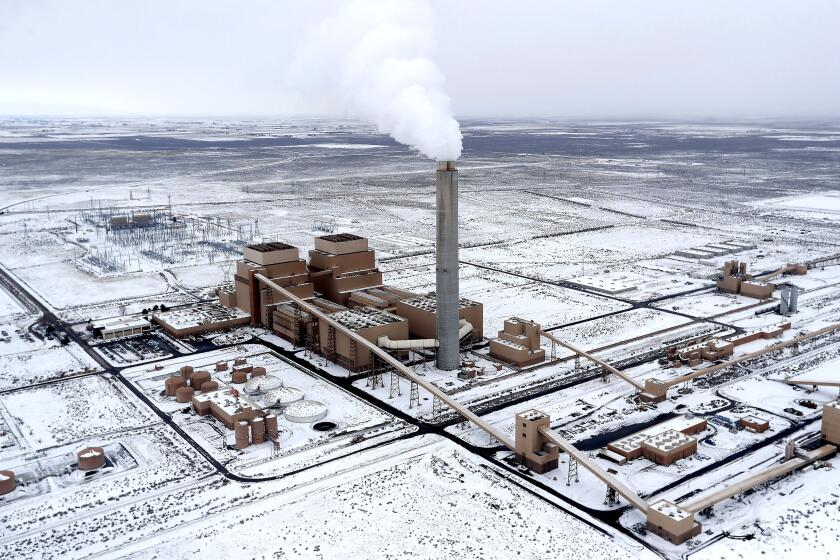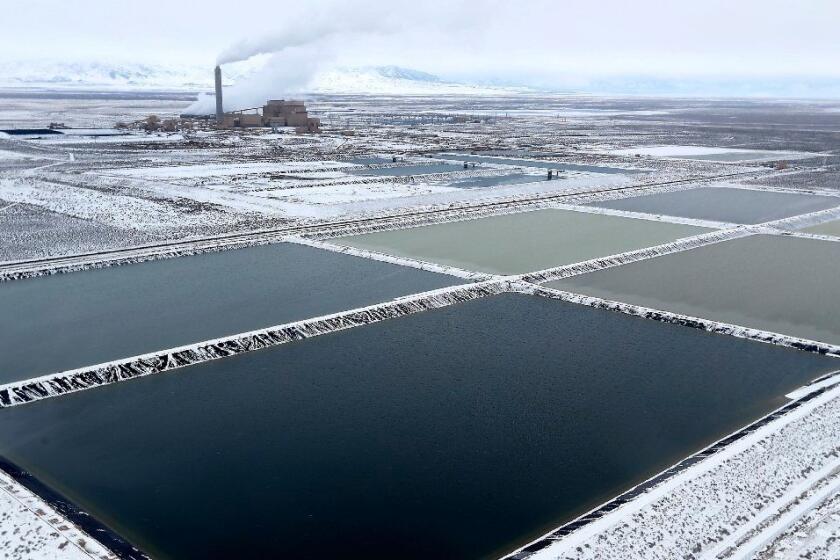Los Angeles OKs a deal for record-cheap solar power and battery storage

- Share via
For a long time, there were two big knocks against solar power: It’s expensive, and it can’t keep the lights on after sundown.
A contract approved Tuesday by the Los Angeles Department of Water and Power shows how much that reality has changed.
Under the 25-year deal with developer 8minute Solar Energy, the city would buy electricity from a sprawling complex of solar panels and lithium-ion batteries in the Mojave Desert of eastern Kern County, about two hours north of Los Angeles. The Eland project would meet 6% to 7% of L.A.’s annual electricity needs and would be capable of pumping clean energy into the grid for four hours each night.
The combined solar power and energy storage is priced at 3.3 cents per kilowatt-hour — a record low for this type of contract, city officials and independent experts say, and cheaper than electricity from natural gas.
The Eland deal’s approval was delayed last month after DWP staff said concerns had been raised by the union representing employees of the city-run utility.
It wasn’t clear whether the International Brotherhood of Electrical Workers Local 18 had specific objections to the Eland project. But the union has been on the attack against L.A. Mayor Eric Garcetti since his decision in February to shut down three natural-gas-fired power plants along the coast, which could force hundreds of union workers to transition to new jobs.
Concerns have been raised by a powerful labor union, which is also battling Mayor Eric Garcetti over his Green New Deal.
At the department’s Board of Commissioners meeting Tuesday, DWP staff members said they were satisfied they had met their formal obligation to inform the union about renewable energy projects.
They also said a Project Labor Agreement with IBEW Local 428 in Kern County has been signed by the developer. It had been completed but not signed before last month’s DWP board meeting, when the Eland deal failed to get enough votes to move to the City Council for final approval.
That satisfied the commissioners, who voted unanimously to send the contract to the City Council.
“My issues last time centered not around — someone said, ‘our labor boss’ — whether he was on board or not,” said Commissioner Cynthia McClain-Hill, referring to IBEW Local 18’s powerful top executive, Brian D’Arcy. “My concerns centered around this department’s obligation to comply with all of its governing documents, all of its contractual agreements.”
A spokesman for Local 18, however, insisted the DWP is “not in compliance” with its union contract, and therefore the Eland contract is not in compliance either. He declined to provide further details.
“IBEW will use the dispute process in the contract to remedy the issues,” the spokesman said in an email.

The commissioners also said they were motivated by climate change activists from groups including the Sunrise Movement, Food & Water Watch and Democratic Socialists of America, who rallied in front of the DWP’s downtown headquarters Tuesday, then packed the board meeting and urged approval of the solar deal.
The activists cited the threat posed by bigger wildfires and other climate change effects, saying Los Angeles can set a bold example for the rest of the country and the world by moving quickly to transition away from fossil fuels. Approving a solar contract for a project that will employ union workers, they said, is part of that example.
“We have to act like our house is on fire. Because it is,” said Jasmin Vargas, an organizer with Food & Water Watch, paraphrasing the 16-year-old climate activist Greta Thunberg.
They also emphasized the local pollution produced by fossil fueled power plants and oil and gas extraction, and how it contributes to racial and economic injustice.
The war on smog has been called one of America’s greatest environmental successes.
Following chants of “What do we want? Climate justice! When do we want it? Now!” outside DWP headquarters, Sunrise Movement activist Gaby Markley said her grandparents have lived in L.A.’s Porter Ranch neighborhood for more than 20 years. Residents there suffered from a variety of health issues after the record-setting methane leak from Southern California Gas Co.’s Aliso Canyon storage field.
The Eland solar project, Markley said, would help Los Angeles reduce its reliance on gas.
“Workers and communities at the forefront of this crisis, like my grandparents, deserve basic rights,” she said. “This is about all of our rights to breathe clean air and drink clean water, and to protect the ones that we love.”
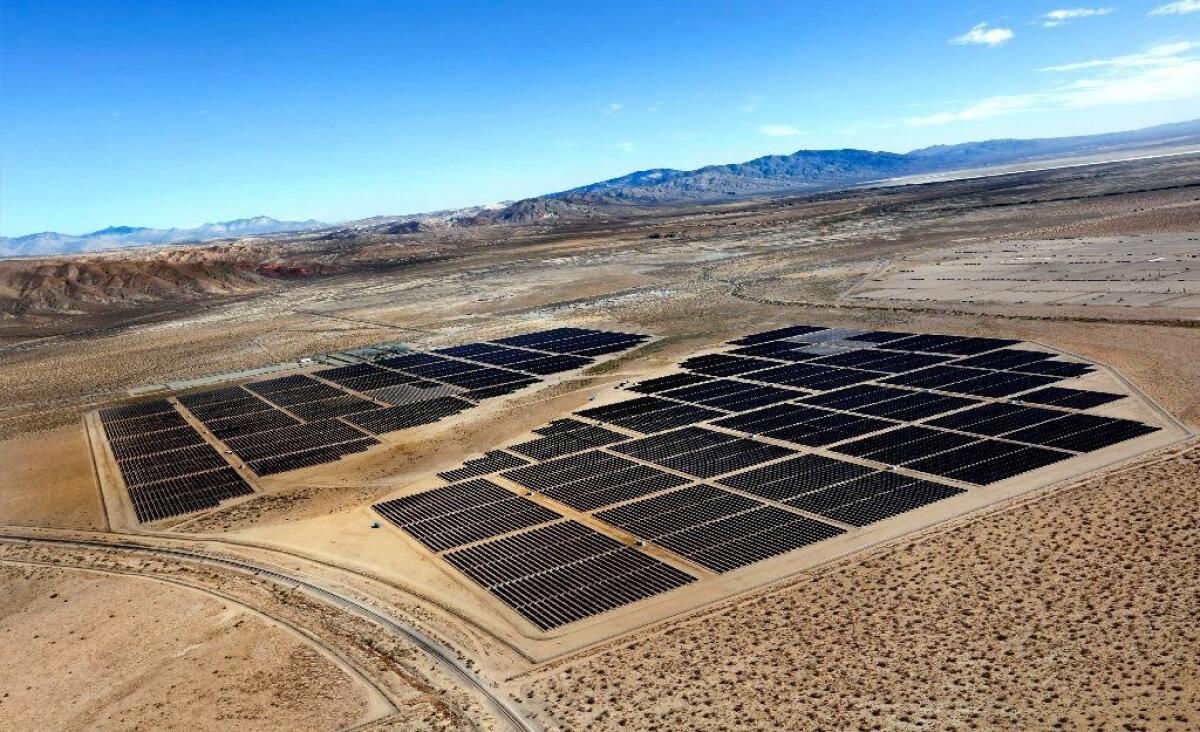
Glendale is also expected to buy a small share of the Eland project’s output. That contract is still being negotiated, said Mark Young, the city’s integrated resources planning administrator.
Renewables, gas and the climate crisis
Los Angeles already gets about one-third of its electricity from renewable sources. But California law requires 100% climate-friendly energy by 2045, a target that will force utilities and local governments to do more than keep buying low-cost solar and wind power.
California frequently produces more solar energy than it can use during the middle of the day, then fires up gas plants in the evening to meet electricity demand after sundown.
DWP officials say they’re shifting their attention to banking clean energy for nighttime use, with projects such as Eland.
“Any renewable energy project with solar, we’re looking to pair it with storage. We’re not looking for any solar by itself,” Reiko Kerr, the DWP’s senior assistant general manager for power system engineering, said in an interview this year.
Large amounts of energy storage will almost certainly be needed to help replace the coastal gas plants that Garcetti decided would be shut down. A few months after announcing that decision, the mayor unveiled his Green New Deal plan, which sets targets of 80% renewable energy and 3,000 megawatts of energy storage for Los Angeles by the mid-2030s.
For now, the DWP still operates a natural gas plant in Sun Valley, known as the Valley Generating Station. And the city plans to build a new gas-fired power plant in rural Utah, with construction scheduled to begin this year.
The 840-megawatt facility will help replace Los Angeles’s single largest power source, the Intermountain coal plant, which provides about one-fifth of the city’s electricity and is slated to shut down in 2025.

Critics say the new gas plant flies in the face of the mayor’s climate agenda and the state’s clean energy goals. They’ve argued the city should replace the coal plant with renewable energy, not a different fossil fuel.
“Eland alone is not going to solve the crisis. We have to come here again next month about Intermountain Power Plant, and then the next month about something else, and so on until the work of total decarbonization is finally done,” Tom Pike, an activist with Democratic Socialists of America, said during Tuesday’s rally.
L.A. will build a gas-fired power plant in Utah, even as Mayor Eric Garcetti touts a “Green New Deal” to fight climate change.
Does California’s power grid need gas?
There’s an active debate among energy experts about how much gas, if any, California will need to maintain reliable electricity as its grid is dominated more and more by solar and wind power, both of which vary with the weather and the time of day.
Lithium-ion batteries can store a few hours’ worth of energy, but they can’t keep the lights on all night. They also aren’t much help when the sun disappears behind clouds for several days.
Energy and Environmental Economics, a San Francisco-based consulting firm influential among state officials, concluded in a study released in June that California will still need 17,000 to 35,000 megawatts of natural gas capacity in the middle of the century. At the high end, that’s not far from the 41,000 megawatts of gas installed in the state today.
The “firm generation” from gas plants would serve as backup for solar and wind, and would be especially important during multiday periods when solar and wind production are both low.
The study was commissioned by Calpine Corp., which owns gas plants across California and describes itself as the nation’s largest generator of gas-fired electricity. Arne Olson, a senior partner at Energy and Environmental Economics and one of the study’s coauthors, acknowledged that several technologies could reduce or eliminate the need for natural gas, but said none of those technologies is commercially available yet.
Without some gas, Olson said, the costs of reducing planet-warming emissions “are so far out of bounds.”
“The only way you could actually do it [is] to massively overbuild the solar and wind,” he said.
Los Angeles hopes to store solar and wind power in underground salt caverns, to help replace a giant coal plant.
Other experts are more hopeful about eliminating gas. They say California could invest in offshore wind turbines, which generate electricity more consistently than onshore turbines, or import more renewables from other states, where the sun shines and the wind blows at different times of day.
There are also several technologies that could eventually provide long-duration energy storage, including hydrogen, compressed air and flow batteries.
“The case for gas is probably overstated,” Ric O’Connell, executive director of the Berkeley nonprofit consulting group GridLab, said in an email, referring to the Calpine study. “But the problem is real, and we will need to figure out how to solve it.”


